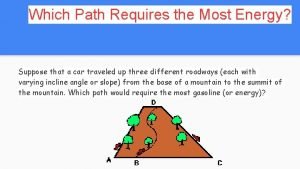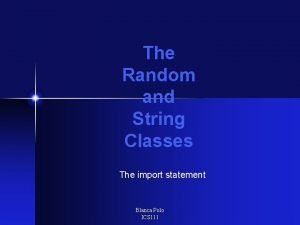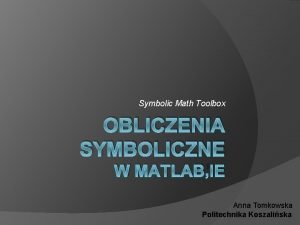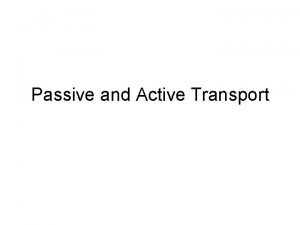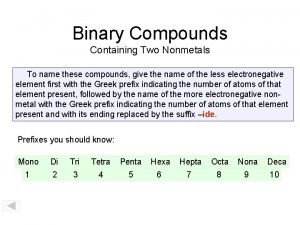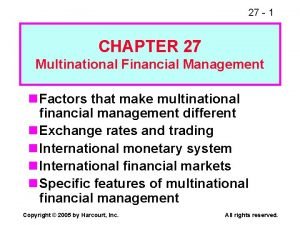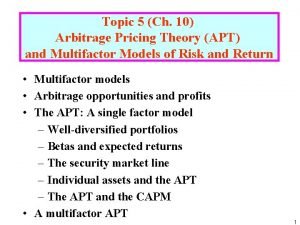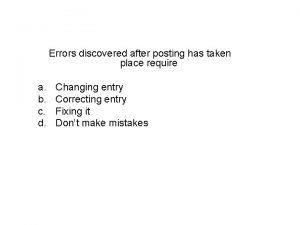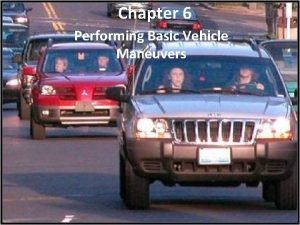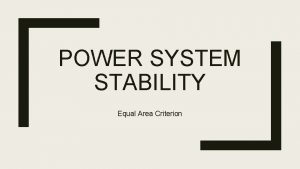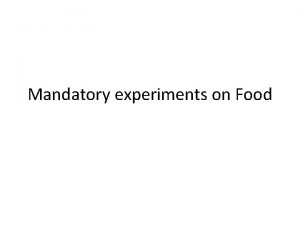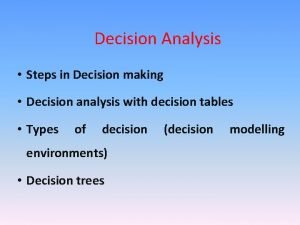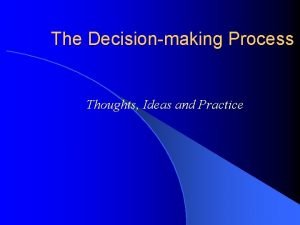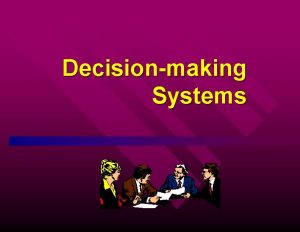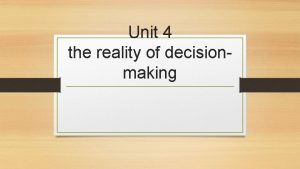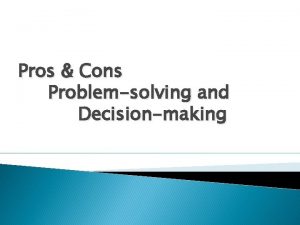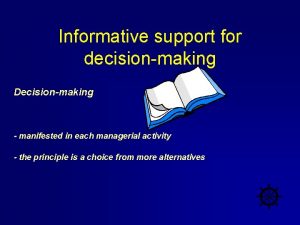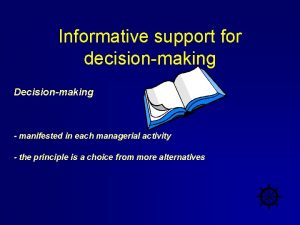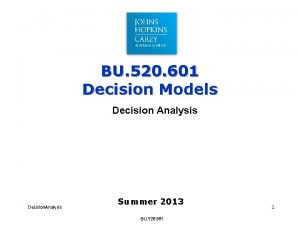Decision Analysis Decision Analysis Effective decisionmaking requires that






















































- Slides: 54

Decision Analysis

Decision Analysis • Effective decision-making requires that we understand: – The nature of the decision that must be made – The values, goals, and objectives that are relevant to the decision problem – The areas of uncertainty that affect the decision – The consequences of each possible decision 2

A Decision-Making Model Consider the following five-part decision-making model: Identify Problem Formulate and Implement Model Analyze Model Test Results Implement Solution Most important Unsatisfactory Results Adapted from Winning Decisions, by Russo and Shoemaker 3

Anchoring and Framing • Errors in judgment arise due to what psychologists term anchoring and framing

Anchoring • A seeming trivial factor serves as a starting point (anchor) for estimations • Decision makers adjust their estimates but remain too close to the anchor. • 2 groups are asked to estimate the value of: § 1 X 2 X 3 X 4 X 5 X 6 X 7 X 8 or § 8 X 7 X 6 X 5 X 4 X 3 X 2 X 1 • Median estimate of first series was 512 • Median estimate of 2 nd series was 2, 250 • The order, of course, is meaningless and the answer is 40, 320

Framing • Affects how a decision maker perceives the alternatives in a decision – often involves a win/loss perspective • The way the problem is framed influences the choices

Framing Example • You have been given $1, 000 but must choose between the following alternatives: a) Receive an additional $500 with certainty or b) Flip a coin and receive an additional $1, 000 if heads or $0 if tails • a) is a sure win and the choice most people prefer • Now suppose you are given $2, 000 and must choose between a) Give back $500 immediately or b) Flip a coin and give back $0 if heads or $1, 000 if tails • When framed this way, alternative a) is a “sure loss” and many people who previously preferred alternative a) now opt for alternative b) (because it holds a chance of avoiding a loss) • However it is clear that in both cases the a) alternative guarantees a total payoff of $1, 500, whereas b) offers a 50% chance of a $2, 000 total payoff and a 50% chance of $1, 000 total payoff. • A rational decision maker should focus on the consequences of his/her choices and consistently select the same alternative, regardless of how the problem is framed

A Framing Example “Careful analysis at a major U. S. steel company showed it could save hundreds of thousands of dollars per year by replacing its hot-metal mixing technology, which required that metal be heated twice, with direct-pouring technology, in which the metal was only heated once. But the move was approved only after considerable delay because senior engineers complained that the analysis did not include the cost of the hot metal mixers that had been purchased for $3 million just a few years previously. ” How would you critique this decision? Adapted from Winning Decisions, by Russo and Shoemaker 8

Decision Trees and Decision Tables • Often our problem solutions require decisions to be made according to two or more conditions or combinations of conditions • Decision trees represent such decision as a sequence of steps • Decision tables describe all possible combinations of conditions and the decision appropriate to each combination • Levels of uncertainty can also be built into decision trees to account for the relative probabilities of the various outcomes 9

Decision Tree Showing Possible Outcomes Projected Sales Results A. 1 Sales Up 10% A. 2 Sales Up 15% B. 1 Sales Up 5% B. 2 Sales Even Outcome A Decision Made Outcome B 10

Decision Tree of Outcomes -- Quantifying Uncertainties Projected Sales Results A. 1 Sales Up 10% 32% 20% A. 2 Sales Up 15% 8% 70% B. 1 Sales Up 5% 42% 30% B. 2 Sales Even 80% Outcome A 40% Decision Made 60% Outcome B 18% 11

An Example

Evaluating Your Decision Tree Start by assigning a cash value or score to each possible outcome. Estimate how much you think it would be worth to you if that outcome came about. Next look at each circle (representing an uncertainty point) and estimate the probability of each outcome. If you use percentages, the total must come to 100% at each circle. If you use fractions, these must add up to 1. If you have data on past events you may be able to make rigorous estimates of the probabilities. Otherwise write down your best guess. -

Calculating Tree Values • Once you have worked out the value of the outcomes, and have assessed the probability of the outcomes of uncertainty, it is time to start calculating the values that will help you make your decision. • Start on the right hand side of the decision tree, and work back towards the left. As you complete a set of calculations on a node (decision square or uncertainty circle), all you need to do is to record the result. You can ignore all the calculations that lead to that result from then on. –

Calculating The Value of Uncertain Outcome Nodes Calculating the value of uncertain outcomes (circles on the diagram): Multiply the value of the outcomes by their probability. The total for that node of the tree is the total of these values. In the example in Figure 2, the value for 'new product, thorough development' is: 0. 4 (probability good outcome) x $1, 000 (value) = $400, 000 0. 4 (probability moderate outcome) x $50, 000 (value) = $20, 000 0. 2 (probability poor outcome) x $2, 000 (value) = $400 + $420, 400 -

Calculating the Value of Decision Nodes When evaluating a decision node, write down the cost of each option along each decision line. Then subtract the cost from the outcome value that you have already calculated. This will give you a value that represents the benefit of that decision. Note that amounts already spent do not count for this analysis – these are 'sunk costs' and (despite emotional counter-arguments) should not be factored into the decision. When you have calculated these decision benefits, choose the option that has the largest benefit, and take that as the decision made. This is the value of that decision node. Figure 4 shows this calculation of decision nodes in our example: In this example, the benefit we previously calculated for 'new product, thorough development' was $420, 400. We estimate the future cost of this approach as $150, 000. This gives a net benefit of $270, 400. The net benefit of 'new product, rapid development' was $31, 400. On this branch we therefore choose the most valuable option, 'new product, thorough development', and allocate this value to the decision node.

Result By applying this technique we can see that the best option is to develop a new product. It is worth much more to us to take our time and get the product right, than to rush the product to market. However, if we decide to consolidate, It is better just to improve our existing products than to botch a new product

Example of Using a Decision Tree or Table to Capture Complex Business Logic Consider the following excerpt from an actual business document: If the customer account is billed using a fixed rate method, a minimum monthly charge is assessed for consumption of less than 100 kwh. Otherwise, apply a schedule A rate structure. However, if the account is billed using a variable rate method, a schedule A rate structure will apply to consumption below 100 kwh, with additional consumption billed according to schedule B. 18

Articulating Complex Business Rules n n Complex business rules, such as our example, can become rather confusing Capturing such rules in text form alone can lead to ambiguity and misinterpretation As an alternative, it is often wise to capture such rules in decision tress or decision tables The examples on the following slides will illustrate this technique

Decision Tree for this Example fixed rate billing variable rate billing < 100 kwh minimum charge >= 100 kwh schedule A < 100 kwh schedule A >= 100 kwh ? 20

Decision Tree for this Example fixed rate billing variable rate billing < 100 kwh minimum charge >= 100 kwh schedule A < 100 kwh schedule A >= 100 kwh schedule A on first 99 kwh schedule B on kwh 100 and above 21

Decision Table for Example – Version 1 Conditions Fixed rate acct Variable rate acct Consumption < 100 kwh Consumption >= 100 kwh 1 Rules 2 3 4 T F T F T 5 F F Is this a valid business case? Did we miss something? Actions Minimum charge Schedule A on first 99 kwh, Schedule B on kwh 100 + X X 22

Decision Table for Example – Version 2 Conditions Account type Consumption 1 fixed < 100 Rules 2 3 fixed variable >=100 <100 4 variable >= 100 Actions Minimum charge Schedule A on first 99 kwh, Schedule B on kwh 100 + X X 23

Activity Consider the following description of a company’s matching retirement contribution plan: Acme Widgets wants to encourage its employees to save for retirement. To promote this goal, Acme will match an employee’s contribution to the approved retirement plan by 50% provided the employee keeps the money in the retirement plan at least two years. However, the company limits matching contributions depending on the employee’s salary and time of service as follows. Acme will match five, six, or seven percent of the first $30, 000 of an employee's salary if he or she has been with the company for at least two, five, or ten years respectively. If the employee has been with the company for at least five years, the company will match up to four percent of the next $25, 000 in salary and three percent of any excess. Ten-year plus workers get a five percent match from $30, 000 to $55, 000. Long-term service employees (fifteen years or more) get seven percent on the first $30, 000 and five percent after that. 24

Team Activity (cont’d) 1) 2) 3) Do one of the following tasks according to your instructor’s directions: a) Create a decision tree that captures the business rules in this policy. b) Create a decision table that captures the business rules in this policy. Did your analysis uncover any questions, ambiguities, or missing rules? If so, do you think these would be as easy to spot and to analyze using only the narrative description of this policy? 25

Developing a More Complex Decision Table 26

Developing More Complex Decision Tables In the 1950's General Electric, the Sutherland Corporation, and the United States Air Force worked on a complex file maintenance project, using flowcharts and traditional narratives, they spent six labor-years of effort but failed to define the problem. It was not until 1958, when four analysts using decision tables, successfully defined the problem in less than four weeks 1. ___________________ 1 Taken from “A History of Decision Tables” located at http: //www. catalyst. com/products/logicgem/overview. html

Steps to create a decision table 1. List all the conditions which determine which action to take. 2. Calculate the number of rules required. – Multiple the number of values for each condition by each other. • Example: Condition 1 has 2 values, Condition 2 has 2 values, Condition 3 has 2 values. Thus 2 X 2 = 8 rules 3. Fill all combinations in the table. 4. Define the action for each rule 5. Analyze column by column to determine which actions are appropriate for each rule. 6. Reduce the table by eliminating redundant columns.

All possible combinations Conditions <cond-1> F T F T … T <cond-2> F F T T … T <cond-3> F F T T … T … Actions … <cond-n> F F F F … T <action-1> X X X X <action-2> X X <action-3> X X X … <action-m> … X X Actions per combination (each column represents a different state of affairs)

Example • Policy for charging charter flight costumers for certain in-flight services: 2 If the flight is more than half-full and costs more than $350 per seat, we serve free cocktails unless it is a domestic flight. We charge for cocktails on all domestic flights; that is, for all the ones where we serve cocktails. (Cocktails are only served on flights that are more than half-full. ) ___________________ 2 Example taken form: Structured Analysis and System Specification, Tom de Marco, Yourdon inc. , New York,

List all the conditions that determine which action to take. Conditions Values The flight more than half-full? Yes (Y), No (N) Cost is more than $350? Y, N Is it a domestic flight? Y, N

Calculate the space of combinations Conditions Number of Combinations Possible Combinations/ Rules 1 2 Y N 2 4 Y N Y Y Y N N N 3 8 Y N Y Y Y N N Y … … n 2 n Y Y N N N

Calculate the Number of Rules in Table • Conditions in the example are 3 and all are two -valued ones, hence we have: All combinations are 23 = 8 rules OR 2 X 2 = 8 rules

Fill all rules in the table. POSSIBLE RULES ACTIONS CONDITONS more than half-full N N Y Y more than $350 per seat N N Y Y domestic flight N Y N Y

Analyze column by column to determine which actions are appropriate for each combination POSSIBLE RULES ACTIONS CONDITONS more than half-full N N Y Y more than $350 per seat N N Y Y domestic flight N Y N Y serve cocktails X X free X

Reduce the table by eliminating redundant columns. POSSIBLE COMBINATIONS ACTIONS CONDITONS more than halffull N N Y Y more than $350 per seat N N Y Y domestic flight N Y N Y serve cocktails X X free X Note that some columns are identical except for one condition.

Reduce the table by eliminating redundant columns. POSSIBLE RULES ACTIONS CONDITONS more than halffull N N Y Y more than $350 per seat N N Y Y domestic flight N Y N Y serve cocktails X X free X Note that some columns are identical except for one condition. Which means that actions are independent from the value of that particular condition.

Reduce the table by eliminating redundant columns. POSSIBLE RULES ACTIONS CONDITONS more than halffull N N Y Y more than $350 per seat N N Y Y domestic flight N Y N Y serve cocktails X X free X Note that some columns are identical except for one condition. Which means that actions are independent from the value of that particular condition. Hence, the table can be simplified.

Reduce the table by eliminating redundant columns. POSSIBLE RULES ACTIONS CONDITONS more than halffull N N N Y Y more than $350 per seat N Y Y N N Y Y domestic flight - N Y N Y serve cocktails X X free X First we combine the yellow ones nullifying the condition.

Reduce the table by eliminating redundant columns. POSSIBLE RULES ACTIONS CONDITONS more than halffull N more than $350 per seat N Y N N Y Y domestic flight - - N Y serve cocktails X X free X N Y Y First we combine the yellow ones nullifying the condition. Then the red ones.

Reduce the table by eliminating redundant columns. POSSIBLE RULES ACTIONS CONDITONS more than halffull N more than $350 per seat N Y N N Y Y domestic flight - - N Y serve cocktails X X free X N Y Y First we combine the yellow ones nullifying the condition. Then the red ones. Notice that yellow and red columns are identical but by one condition.

Reduce the table by eliminating redundant columns. POSSIBLE RULES ACTIONS CONDITONS First we combine the yellow ones nullifying the condition. more than halffull N more than $350 per seat - N N Y Y domestic flight - N Y Notice that yellow and red columns are identical but by one condition. serve cocktails X X So, we combine them. free X Y Y Then the red ones.

Reduce the table by eliminating redundant columns. POSSIBLE RULES ACTIONS CONDITONS First we combine the yellow ones nullifying the condition. more than halffull N more than $350 per seat - N Y Y domestic flight - - N Y Notice that yellow and red columns are identical but by one condition. serve cocktails X X X So, we combine them. free X Y Y Y Then the red ones. Then we combine the violet colored ones.

Reduce the table by eliminating redundant columns. POSSIBLE RULES ACTIONS CONDITONS more than halffull N Y Y Y more than $350 per seat - N Y Y domestic flight - - N Y serve cocktails X X X free X Notice that even when we observe that the green columns are identical except for one condition we do not combine them: A “NULLIFIED” condition is not the same as a valued one. What about this rule? Have we over looked something?

Final Solution ACTIONS CONDITONS Rules more than half-full N Y Y Y more than $350 per seat - N Y Y domestic flight - - N Y serve cocktails X X X free X

Complex Decision Table Exercise A company is trying to maintain a meaningful list of customers. The objective is to send out only the catalogs from which customers will buy merchandise. The company realizes that certain loyal customers order from every catalog and some people on the mailing list never order. These customers are easy to identify. Deciding which catalogs to send to customers who order from only selected catalogs is a more difficult decision. Once these decisions have been made by the marketing department, you as the analyst have been asked to develop a decision table for the three conditions described below. Each condition has two alternatives (Y or N): 1. Customer ordered from Fall catalog 2. Customer ordered from Christmas catalog 3. Customer ordered from Specialty catalog The actions for these conditions, as determined by marketing, are described on the next slide. 46

Complex Decision Table Exercise Customers who ordered from all three catalogs will get the Christmas and Special catalogs. Customers who ordered from the Fall and Christmas catalogs but not the Special catalog will get the Christmas catalog. Customers who ordered from the Fall catalog and the Special catalog but not the Christmas catalog will get the Special catalog. Customers who ordered only from the Fall catalog but no other catalog will get the Christmas catalog. Customers who ordered from the Christmas and Special catalogs but not the Fall catalog will get both catalogs. Customers who ordered only from the Christmas catalog or only from the Special catalog will get only the Christmas or Special catalogs respectively. Customers who ordered from no catalog will get the Christmas catalog. 1. Create a simplified decision table (or tree) based on the above decision logic. 47

Solution to Decision Table Exercise The four gray columns can be combined into a single rule. Note that for each, there was NO order placed from the Special Catalog. In addition, Rules 1 & 5 and Rules 3 & 7 can be combined. Each pair produces the same action and each pair shares two common conditions.

Solution to Decision Table Exercise~ Final Version

Another Example: “A marketing company wishes to construct a decision table to decide how to treat clients according to three characteristics: Gender, City Dweller, and age group: A (under 30), B (between 30 and 60), C (over 60). The company has four products (W, X, Y and Z) to test market. Product W will appeal to female city dwellers. Product X will appeal to young females. Product Y will appeal to Male middle aged shoppers who do not live in cities. Product Z will appeal to all but older females. ”

The process used to create this decision table is the following: 1. Identify conditions and their alternative values. There are 3 conditions: gender, city dweller, and age group. Put these into table as 3 rows in upper left side. Gender’s alternative values are: F and M. City dweller’s alternative values are: Y and N Age group’s alternative values are: A, B, and C 2. Compute max. number of rules. Determine the product of number of alternative values for each condition. 2 x 3 = 12. Fill table on upper right side with one column for each unique combination of these alternative values. Label each column using increasing numbers 1 -12 corresponding to the 12 rules. For example, the first column (rule 1) corresponds to F, Y, and A. Rule 2 corresponds to M, Y, and A. Rule 3 corresponds to F, N, and A. Rule 4 corresponds to M, N, and A. Rule 5 corresponds to F, Y, and B. Rule 6 corresponds to M, Y, and B and so on. 3. Identify possible actions Market product W, X, Y, or Z. Put these into table as 4 rows in lower left side. 4. Define each of the actions to take given each rule. For example, for rule 1 where it is F, Y, and A; we see from the above example scenario that products W, X, and Z will appeal. Therefore, we put an ‘X’ into the table’s intersection of column 1 and the rows that correspond to the actions: market product W, market product X, and market product Z.

Gender 1 F 2 M 3 F 4 M 5 F 6 M 7 F 8 M 9 F 10 M 11 F 12 M City Age Market W Y A X Y A N A Y B X Y B N B Y C X Y C N C Market. X X X Market. Y X Market. Z X X X X X

5. Verify that the actions given to each rule are correct. 6. Simplify the table. Determine if there are rules (columns) that represent impossible situations. If so, remove those columns. There are no impossible situations in this example. Determine if there are rules (columns) that have the same actions. If so, determine if these are rules that are identical except for one condition and for that one condition, all possible values of this condition are present in the rules in these columns. In the example scenario, columns 2, 4, 6, 7, 10, and 12 have the same action. Of these columns: 2, 6, and 10 are identical except for one condition: age group. The gender is M and they are city dwellers. The age group is A for rule 2, B for rule 6, and C for rule 10. Therefore, all possible values of condition ‘age group’ are present. For rules 2, 6, and 10; the age group is a “don’t care”. These 3 columns can be collapsed into one column and a hyphen is put into the age group location to signify that we don’t care what the value of the age group is, we will treat all male city dwellers the same: market product Z.

Final Decision Table 1 2 3 4 5 6 7 8 9 10 Gender F M F M F M City Y Y N N Age A A A B B B C C C Market. W X X X Market. X X X Market. Y X Market. Z X X X X X
 Survey of household economics and decisionmaking
Survey of household economics and decisionmaking Phân độ lown ngoại tâm thu
Phân độ lown ngoại tâm thu Block nhĩ thất độ 3
Block nhĩ thất độ 3 Thể thơ truyền thống
Thể thơ truyền thống Thơ thất ngôn tứ tuyệt đường luật
Thơ thất ngôn tứ tuyệt đường luật Chiến lược kinh doanh quốc tế của walmart
Chiến lược kinh doanh quốc tế của walmart Tìm vết của đường thẳng
Tìm vết của đường thẳng Con hãy đưa tay khi thấy người vấp ngã
Con hãy đưa tay khi thấy người vấp ngã Tôn thất thuyết là ai
Tôn thất thuyết là ai Gây tê cơ vuông thắt lưng
Gây tê cơ vuông thắt lưng Sau thất bại ở hồ điển triệt
Sau thất bại ở hồ điển triệt No decision snap decision responsible decision
No decision snap decision responsible decision Financial management process
Financial management process Decision table and decision tree examples
Decision table and decision tree examples Effective job analysis
Effective job analysis Articles of the code of ethics are broad statements
Articles of the code of ethics are broad statements Code of ethics three major sections
Code of ethics three major sections Simple and paragraph
Simple and paragraph Level of product availability
Level of product availability ไทย
ไทย Photosynthesis requires
Photosynthesis requires True or false: mla requires a title page.
True or false: mla requires a title page. Four handed seat carry
Four handed seat carry Genre of an essay
Genre of an essay Which path requires the most energy
Which path requires the most energy Using the random class requires an import statement.
Using the random class requires an import statement. Z symbol math
Z symbol math A nine box matrix requires assessing employees on ________.
A nine box matrix requires assessing employees on ________. Vegetative reproduction requires mieosis.
Vegetative reproduction requires mieosis. Sexual reproduction
Sexual reproduction An intense play activity that requires substantial energy
An intense play activity that requires substantial energy Active transport
Active transport Unlike passive transport, active transport requires *
Unlike passive transport, active transport requires * Intersubjectivity requires accepting
Intersubjectivity requires accepting Interest rate parity example
Interest rate parity example Awareness requires totally focusing attention on the task.
Awareness requires totally focusing attention on the task. Compounds containing two nonmetals.
Compounds containing two nonmetals. Multinational financial management requires that
Multinational financial management requires that The apt requires a benchmark portfolio
The apt requires a benchmark portfolio Interpersonal communication competence requires
Interpersonal communication competence requires What do errors discovered after posting require?
What do errors discovered after posting require? Thorndike connectionism
Thorndike connectionism Conscience formation requires a habit of
Conscience formation requires a habit of Chapter 6 performing basic vehicle maneuvers
Chapter 6 performing basic vehicle maneuvers Automated build process
Automated build process What the lord requires of you
What the lord requires of you Equal area criterion in power system
Equal area criterion in power system What food test requires heat
What food test requires heat Requires unbiased and careful questioning
Requires unbiased and careful questioning A good layout requires determining
A good layout requires determining 128x128 image with 64 gray levels requires
128x128 image with 64 gray levels requires Moment of inertia for a hoop
Moment of inertia for a hoop Principles of assessment flexibility
Principles of assessment flexibility Uranus requires 84 years
Uranus requires 84 years The belmont principle of beneficence requires that:
The belmont principle of beneficence requires that:
























